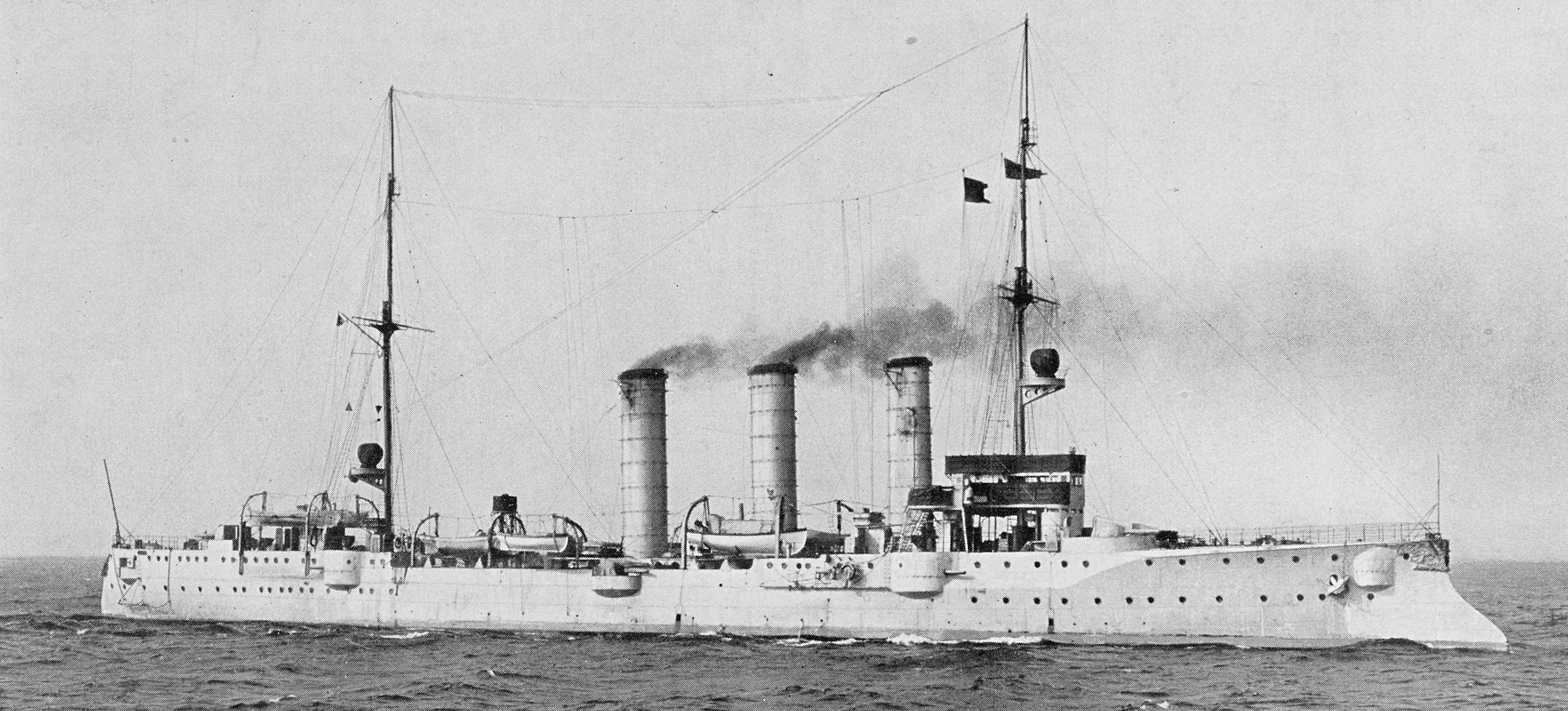What do you do when you already have what looked like the best in the world? Try and make it better. Like a lot of countries in the future the Panagaean Navy tried putting a 6" armament on too small a vessel. They found that trying to handle 100 pound shells on a deck heaving, like only a destroyer can, at speed, could be dangerous. Also the rate of fire was very low for the same reasons, and crew fatigue fell very quickly. The ships were stuck with their armament until after the war as replacing the guns was not a wartime priority. But because of that, the ships were escorts for ships between Panagaea and Panama. Probably the best change for the ships was the removal of the twin 18" torpedoes and their replacement with triple 21". Because of the continued advances in machinery/turbines, the funnels were slightly smaller than those on the Orca class despite there being 6,000shp difference.
Late 1916 and the first three of the class are escorting a convoy to Panama when a report that three German cruisers had broken internment and could be going anywhere as there had been no contact with them for more than 48 hours. It turned out that Wolf and Kondor were headed south to sink the old armoured cruiser HMS Thunder (1901) while the Flensburg went north to try and attack shipping around the Panama shipping routes. The Tarpon signalled to the convoy and escorts "Warship to the south". "Tarwhine, head south to investigate". The Tarwhine went south a few thousand yards when the unmistakable upperworks of a German cruiser came into sight. "German cruiser Flensburg" is the report (see photo below). The Flensburg is armed with 10x4.1" guns, the three Tarpon class have 12x6". The Flensburg is in for a shock. The order goes up the mast "Formate on Leader". The three destroyers get into line astern and close the range to the Flensburg. On the Flensburgs bridge the report is three destroyer and the Kommandant smiles. His cruiser should be able to handle three destroyers then sink the fat merchantmen they could see behind them. Both sides open fire at about fifteen thousand yards. To the Flensburgs shock the shell splashes around him are huge in comparison to his shell splashes. Second salvo from the destroyers comes in - two hits, and a fire is started aft with the aft 4.1" knocked out. Next salvo, three more hits. Flensburg is yet to hit any of the destroyers. Another four hits on the Flensburg and half its armament and its torpedoes are out of action, fires are starting to get out of control. 8,000 yard and the Flensburg hits the Tarpon twice and dismounts the center 6". The destroyers are in position and launch torpedoes at the Flensburg which sees the torpedoes launching (they are that close) and turns away. This opens the Flensburg to a position where it can not return fire, its aft gun being knocked out earlier. Another five hits on the Flensburg and gouts of steam from the damaged boilers erupt. The Flensburg is slowing and coming to a stop. The destroyers maneuver to a firing position and launch the second banks of tubes from each ship. Nine torpedoes in the water. Four hits. The Flensburg seems to explode as a magazine blows the ship in half. Medals all round for a text book destroyer action with what was called a 'superior' enemy vessel.
That was the extent of the action encountered by the Tarpon class in WW1. They had been lucky the sea state had been 'light'. The Flensburg would have had the advantage if the sea state had of been heavy or rough. The 1920's and the 6" are finally removed and replaced with single 4". The 3" AA are kept and two single 2 pounder are added for AA use. It is not until the mid 1930's when the ships are taken in hand for a full conversion to Dual Purpose destroyers. The old low angle 4" are deleted and replaced with twin 4". The two 3" are replaced with a quad 2 pounder.
The perfect AA destroyers. 1939, at wars start, the Royal Navy requested the class be seconded to Escort Command out of Liverpool for use as escort Commanders ships on the various convoys. The fury of the war is slowly ramping up and the class loses its first member in June 1940 off the coast of Dunkirk. The Taimen has been acting as a command ship and AA cover for the ships going to the beaches and the jetty. Targeted by a dozen Stukas, the Taimen fought for its life, five hits doomed the ship, but it had destroyed five of its attackers too. To help the cause, to get the troops off the beach, the Taimen ran itself ashore so it could be used as a pick up point and also to still use any of the weapons aboard still in working order. A further day later the Stukas returned and another four hits turned the Taimen into a burning wreck. Four more of the class would be lost, three to U-boats while on convoy duty, the last in the Bay of Biscay, escorting a Gibraltar convoy, being bombed by Ju88's. The remaining three were made use of in the Mediterranean where their AA value was required the most.
